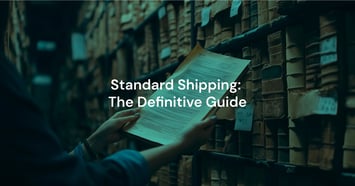How Ecommerce Profitably Scales in 2020 and Beyond

Over the last 12 months, we've had the chance to speak with hundreds of smart people working hard in the ecommerce industry (514, to be exact).
We spoke to industry veterans like Arthur Valdez, Jr. Target's Chief Supply Chain Officer and jammed with founders of rising DTC brands who are thinking about fulfillment in a modern way like Woody Hambrecht of Haus. The full spectrum, each as engaging and hard working as the other.
Patterns emerged that we could see with increasing clarity. I want to share these observations with you.
The drag of shipping
We noticed four truisms that define the state of shipping with ecommerce business models.
There is no question consumer preferences have shifted over the last decade. When making online purchase decisions, factors like availability, experience, loyalty, promotions, convenience and delivery will determine where a customer makes a transaction.
The first truism speaks to the relationship between customer preferences and shipping.
1. Customers want free and fast shipping.
Sometimes just free, sometimes just fast, but often both if they can get it. Brands who provide neither suffer. Brands who provide either/or often miss out on half their market. Brands who provide both tend to increase transactions. This matches our insider experience at Amazon.
How ecommerce companies get to providing both proves to be a complicated journey, as summarized in the next three truisms.
2. Shipping is the biggest operational expense on an ecommerce P&L.
If it's not the top expense, then it's always two or three. Ecommerce operational models are different than physical retail models, which leads shipping to be a bigger constraint on scale and a blight on costs.
3. Sophisticated software is required to optimize the physical parts of numbers 1 and 2 above.
Applying modern software to the physical attributes of a supply chain is a supremely hard problem to solve. The companies who do gain so much leverage by reducing costs and providing additional consumer benefit ("merchandising operational innovation"). Those who don't face poor margins or no path to profitability.
4. Off-the-shelf software is either too rigid or antiquated to adjust to unique needs found company-by-company, forcing most teams to build their own ops stack, which is expensive!
Incumbent 90s era software doesn't have the data science or interoperability required for 2020 era ecommerce companies. Most other newer software options do a good job at solving certain problems, but are proving too inflexible to serve growing companies. Poor integration across the ops stack is a major failure point.
Achieving operational scale
What do these truisms tell us?
They help explain in part why it's so hard to find a competitive edge online. Consumers have choice so they go to where their needs are met. Competition is always an urgent topic for CMOs, but it's increasingly becoming a conversation for COOs, too. In fact, no domain might be more reliant on the partnership between CMO and COO than ecommerce right now.
Capturing those dollars by increasing revenue and improving loyalty ultimately requires operational innovation. We think the fulcrum is sophisticated software comprised of data science, interoperable parts, modern APIs and flexibility.
It's becoming clear that ecommerce companies who want to scale their growth need to focus on three things.
1. Improve customer experience (CX) by integrating frontend and backend systems.
Real-time data flowing between warehouses, inventory, fulfillment, customer communications, the store itself—everything needs to be integrated in order to meet changing consumer demands.
2. Reduce delivery costs.
Delivery costs consist of your fulfillment processes and outbound shipping. You need a path to profitability, so reducing the costs of both is the best route.
3. Optimize inventory placement so the right SKUs are as close to customers as possible.
We are fond of saying "You can only ship things from where they are." Of all sophisticated modeling, the one with the largest impact on speed (customer benefit) and cost reduction (company benefit) is intelligently allocating SKUs as close to potential customers as possible.
By focusing on these three elements, a $50 million company can more profitably scale to $1 billion.
Neglect any of these three, and costs go up while bottlenecks are introduced that slow growth.
Where to go from here
These observations are shaping Shipium's services-orientated platform. Your priorities are unique, but the industry's challenges are universal. We think it's possible both Target and Haus can compete for consumer dollars and loyalty against behemoths like Amazon or Walmart. We want to help make profitable ecommerce scale a reality.

Jason is co-founder and CEO of Shipium where he guides the company's vision towards becoming the world’s best supply chain technology platform for ecommerce and retail. Prior to founding Shipium, he spent 19 years at Amazon as VP of Retail Systems and VP of Forecasting & Supply Chain. While there he owned the global software and operations group that powered Prime, Subscribe & Save and Pricing. He is a University of Washington grad and an engineer at heart who loves solving complex scaling problems.


